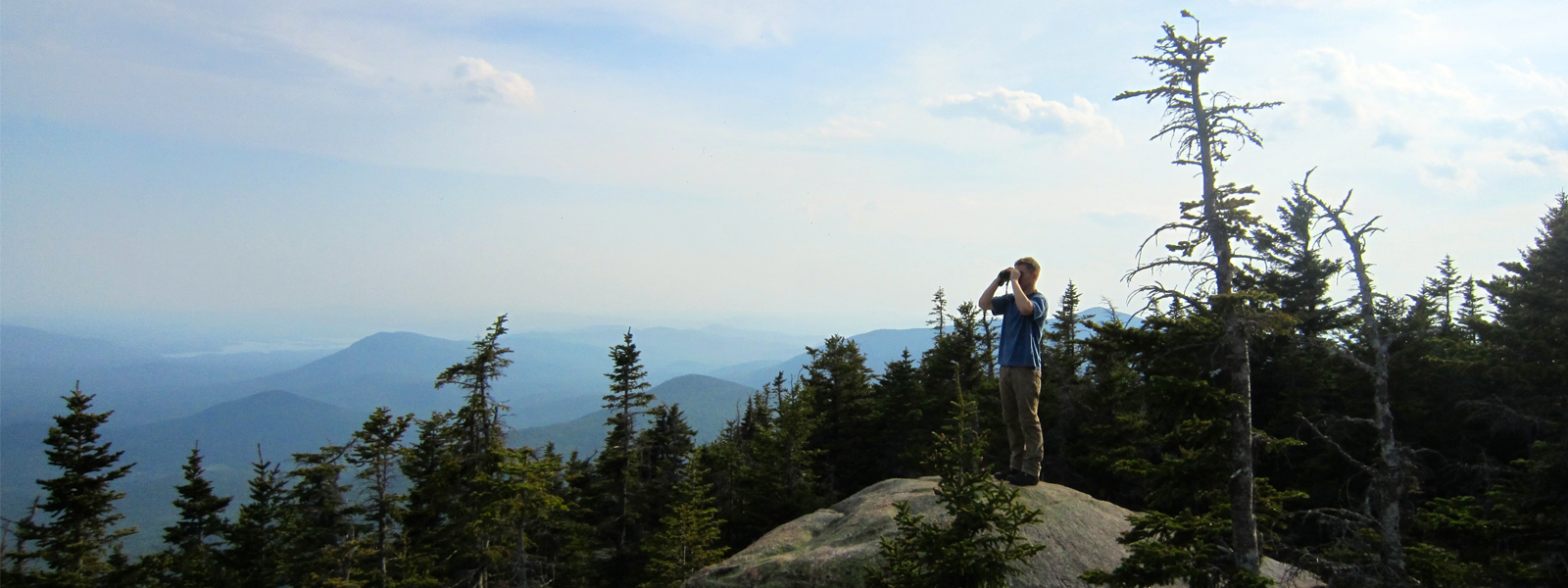Mountain Birdwatch data have been used to analyze how climate change will impact high-elevation bird populations, establish protective management zones in the Green Mountain and White Mountain National Forests, and appropriately site radio towers, wind turbines, and ski trails so as to minimize disturbance to songbirds. We recently published the first fine-scale population estimate for Bicknell’s Thrush–entirely from Mountain Birdwatch data. The resulting article in Ecosphere can be read online for free, and you can interact with or download our online abundance map.
OPEN DATA
We’re continually analyzing these data to help us in understanding how songbird populations are changing in our mountains. We welcome data requests and requests for collaboration. The following data are available as open data:
- Vermont Center for Ecostudies. Mountain Birdwatch 2.0: 2010-2018. KNB Data Repository. 10.5063/F1XW4H49.
- Vermont Center for Ecostudies, J. D. Lambert, and J. Hart. 2015. Mountain Birdwatch 1.0: 2000-2010. KNB Data Repository. doi:10.5063/F1DN430G
SELECTED REPORTS & PUBLICATIONS
- Hallworth, MT, APK Sirén, WV DeLuca, TR Duclos, KP McFarland, JM Hill, CC Rimmer & TL Morelli. 2024. Boom and bust: the effects of masting on seed predator range dynamics and trophic cascades. Diversity and Distributions 30: 13 pp.
- Hill, JM. 2023. The State of the Mountain Birds Report: 2023. Vermont Center for Ecostudies, White River Junction, VT.
- Hill, JM. 2022. The State of the Mountain Birds Report: 2022. Vermont Center for Ecostudies, White River Junction, VT.
- Hill, JM. 2021. The State of the Mountain Birds Report: 2021. Vermont Center for Ecostudies, White River Junction, VT.
- Hill, JM, & J Campbell. 2019. Continued Exploration of the Relationship between Downhill Ski Area Edges and Bicknell’s Thrush in the Northeastern U.S. Using Mountain Birdwatch Data (2016-2019). Vermont Center for Ecostudies. 27 pp.
- Lloyd, J, JM Hill, & KP McFarland. 2017. The State of Mountain Birds: 2017. https://mountainbirds.vtecostudies.org/
- Hill, JM & JD Lloyd. 2017. A fine-scale U.S. population estimate of a montane spruce–fir bird species of conservation concern. Ecosphere 8: 14 pp.
- Ralston, J, DI King, WV DeLuca, GJ Niemi, MJ Glennon, JC Scarl, & JD Lambert. 2015. Analysis of combined data sets yields trend estimates for vulnerable spruce‐fir birds in northern United States. Biological Conservation 187:270–278.
- Frey, SJK, AM Strong, & KP McFarland. 2011. The relative contribution of local habitat and landscape context to metapopulation processes: a dynamic occupancy modeling approach. Ecography 34:1-9.
- Rodenhouse, NL, SN Matthews, KP McFarland, JD Lambert, LR Iverson, A Prasad, TS Sillett, & RT Holmes. 2008. Potential effects of climate change on birds of the Northeast. Mitigation and Adaptation Strategies for Global Change 13:517-540.
- Lambert, JD, DI King, JP Buonaccorsi & LS Prout. 2008. Decline of a New Hampshire Bicknell’s Thrush Population, 1993-2003. Northeastern Naturalist 15:607-618.
- King, D, JD Lambert, JP Buonaccorsi, & LS Prout. 2007. Avian population trends in the vulnerable montane forests of the Northern Appalachians, USA. Biodiversity and Conservation 17:2691-2700.
- Lambert, JD, KP McFarland, CC Rimmer, SD Faccio, & JL Atwood. 2005. A practical model of Bicknell’s Thrush distribution in the northeastern United States. Wilson Bulletin 117:1-11.


